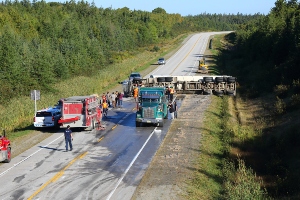 Due to the risks commercial trucks pose to other motorists sharing the roadway, there are several state laws and federal regulations monitoring the trucking industry in Indiana.
Due to the risks commercial trucks pose to other motorists sharing the roadway, there are several state laws and federal regulations monitoring the trucking industry in Indiana.
If a trucking company or driver’s failure to uphold these laws results in an accident, the at-fault party could be held liable for the victim’s medical expenses, loss of income, and pain and suffering. Pfeifer, Morgan & Stesiak’s truck accident lawyers in South Bend know the laws regulating the commercial trucking industry and will help you pursue maximum compensation after an accident.
Below, we have provided a detailed guide to the various laws regulating the commercial trucking industry in Indiana. Contact us to schedule a free, no obligation consultation if you believe you have been injured in a truck accident caused by another’s negligence.
Size and Weight Restrictions
In Indiana, semi-trucks and other commercial vehicles must follow certain size and weight restrictions to be considered safe for driving. With certain exceptions, the following are the maximum weight limits for commercial trucks:
- Maximum possible gross weight: 80,000 pounds
- Maximum single axle weight: 20,000 pounds
- Maximum tandem axle weight: 34,000 pounds
- Maximum tri-axle weight: 50,000 pounds
- Maximum wheel weight: 800 pounds per inch of tire width
Commercial trucks must also follow certain size limitations to operate on the roadway. The width of a commercial truck is usually eight feet six inches or 102 inches wide. Limits on height require no more than 13 feet six inches. The general limit on a truck’s length is a distance of 50 feet from both ends of the vehicle.
Lane Restrictions for Commercial Vehicles
Commercial trucks are also limited to the number of lanes they can use while traveling in Indiana. A commercial truck must use the far-right lane on an interstate highway. However, if there are three or more lanes available, the truck’s driver may use the two right lanes.
The only time a truck driver can use the far-left lane is when he or she is passing another car, entering or exiting the highway, or is trying to avoid a roadway hazard.
Qualifications for Semi-Truck Drivers
Drivers of commercial trucks must have the qualifications, experience and obtain a valid Commercial Driver’s License (CDL) to safely handle the vehicle. To obtain a CDL, the Federal Motor Carrier Safety Administration (FMCSA) requires driver to meet the following qualifications:
- Possess a Commercial Learners Permit (CLP) for 14 days
- Pass the Vehicle Inspection Test
- Pass the Basic Controls Test
- Pass the Road Test
Before issuing a CLP, the FMCSA will check the applicant’s driving records for the last 10 years in all 50 states and the District of Columbia. Additionally, trucking companies must also conduct a thorough background check on an applicant before hiring him or her. This includes the applicant’s driving history, criminal background, and history of drug or alcohol use.
Hours of Service Rule
Truck drivers often work long hours while trying to meet deadlines on a long-haul drive. This may lead to drivers becoming tired or fatigued while driving. To reduce the risk of truck accidents, the FMCSA has imposed an “hours of service” rule that limits the amount of time drivers are able to operate a commercial truck within a 24-hour period.
Under the hours of service rule, commercial truck drivers are required to follow these time limits:
- 11-hour driving limit: Commercial vehicle drivers may drive a maximum of 11 hours after 10 consecutive hours off duty.
- 14-hour driving limit: Commercial vehicle drivers may not drive beyond 14 consecutive hours after coming on duty, following 10 consecutive hours off duty. A driver’s off-duty time does not extend the 14-hour period.
- Rest breaks: A commercial vehicle driver may drive only if eight hours or less have passed since the end of his or her last off-duty period of at least 30 minutes. However, this rule may not apply to drivers who are driving short-hauls.
- 60/70 hour limit: Commercial vehicle drivers may not drive after 60 hours on-duty within seven days, or 70 hours on-duty within eight days. Drivers may restart their consecutive seven or eight-day period after taking 34 or more consecutive hours off duty.
Commercial truck drivers often record the number of hours they drive in a single shift. Likewise, many commercial vehicles carry an event data recorder, or a “black box,” which records the hours a vehicle has traveled. Attorneys can request copies of these records to determine if a truck accident may have been caused by driver error due to an hours of service violation.
Consult a Commercial Trucking Accident Attorney
If you were injured in a truck accident, it is important to consult with an attorney who understands the laws regulating the commercial trucking industry.
Pfeifer, Morgan & Stesiak’s skilled personal injury attorneys in South Bend have helped numerous truck accident victims pursue the parties responsible for their injuries and losses. We will provide you a free, no obligation consultation to review your claim and help you determine if you have a case that entitles you to compensation.
We do not charge our clients upfront legal fees and only require payment if we help you recover compensation for your claim. There is no risk in finding out if you have a case.
Call (574) 444-0741 for a free review of your claim.











